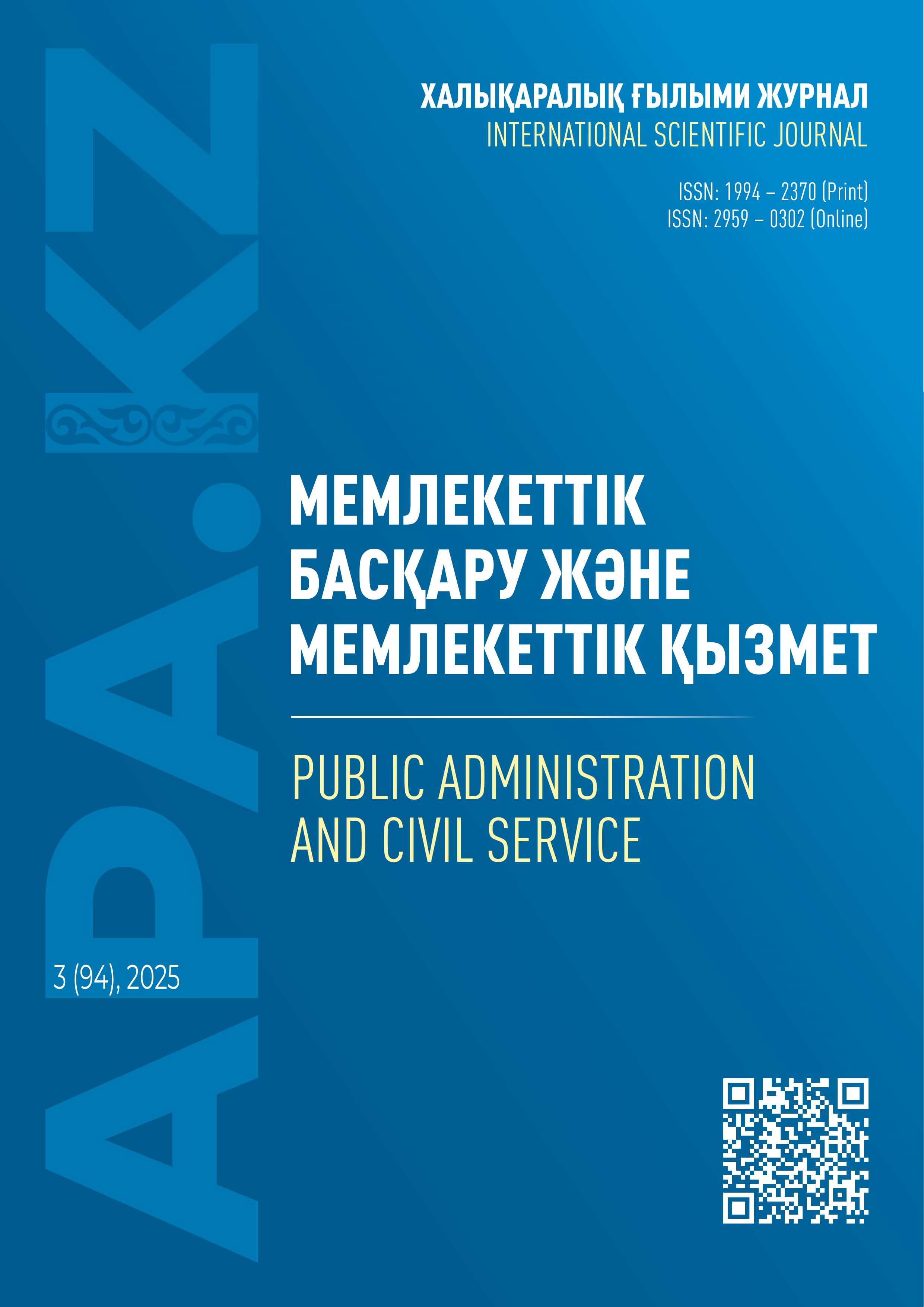PUBLIC SERVICE IN TRANSITION: PAY FAIRNESS, CAREER CLARITY, AND ORGANIZATIONAL ADVOCACY AMONG KAZAKHSTANI CIVIL SERVANTS
DOI:
https://doi.org/10.52123/1994-2370-2025-1513Keywords:
Public Service Motivation; Job Satisfaction; Civil-Service Reform; Kazakhstan; RetentionAbstract
This study provides the first nationwide, mixed-methods portrait of motivational drivers, job satisfaction and reform priorities among Kazakhstan’s civil servants. A purposive-stratified survey of 886 officials from five economic regions and five ministries (March – April 2025) combined validated quantitative scales—Public Service Motivation (PSM), Job Satisfaction Index, organizational-climate items and an employee Net Promoter Score (eNPS)—with an open-ended reform question. Multivariate regression and thematic coding were applied. Job security (63 %) and the desire to contribute to society (49 %) dominate entry motives, confirming a coexistence of instrumental and altruistic rationales. Managerial support and working conditions strongly predict overall satisfaction (β = 0.34 and 0.27, p < 0.01), while career opportunities are the main retention lever (β = 0.41, p < 0.001). Salary dissatisfaction triples the odds of intending to exit for the private sector (OR = 2.8). Despite high educational attainment (18 % master’s degrees), only 27 % of respondents are institutional “promoters”, yielding an eNPS of +6 and signalling fragile advocacy. Gender and cohort effects are pronounced: women exhibit higher loyalty (+10 eNPS points), whereas officials under 30 show the highest exit propensity. Qualitative data highlight inadequate pay, burnout and opaque promotion as chief dysfunctions; yet proposed solutions remain technocratic (digitalisation, salary grids), overlooking relational legitimacy. By integrating PSM theory with eNPS in a hybrid post-Soviet context, the article extends motivation research and identifies policy levers—pay realignment, meritocratic mobility and manager-as-coach models—to stabilise Kazakhstan’s civil-service talent pipeline.
References
Perry J. L., Wise L. R. (1990). The Motivational Bases of Public Service. Public Administration Review, 50 (3), 367–373. https://doi.org/10.2307/976618
Karini A. (2024). Politico-Administrative Culture and Public Service Reform in Post-Independence Kazakhstan. Administrative Sciences, 14 (10), 268. https://doi.org/10.3390/admsci14100268
OECD. (2018). Benchmarking Civil Service Reform in Kazakhstan. OECD Public Governance Reviews. Paris: OECD Publishing. https://doi.org/10.1787/9789264288096-en
Maslow, A. H. (1943). A theory of human motivation. Psychological Review, 50(4), 370–396. https://doi.org/10.1037/h0054346
Herzberg F., Mausner B., Snyderman B. B. (1959). The Motivation to Work (2-е изд.). New York: John Wiley & Sons.
Vroom V. H. (1964). Work and Motivation. New York: John Wiley & Sons.
Deci E. L., Ryan R. M. (2000). Self-Determination Theory and the Facilitation of Intrinsic Motivation, Social Development, and Well-Being. American Psychologist, 55 (1), 68–78. https://doi.org/10.1037/0003-066X.55.1.68
Meyer-Sahling J.-H., Mikkelsen K. S. (2016). Civil Service Laws, Merit, and Motivation: Evidence from a Survey of Personnel Policies in Post-Communist Europe. Public Administration, 94 (4), 1105–1123. https://doi.org/10.1111/padm.12274
Spector P. E. (1997). Job Satisfaction: Application, Assessment, Causes, and Consequences. Thousand Oaks, CA: Sage.
OECD. (2025). Public Governance Scan of Kazakhstan. Paris: OECD Publishing.
Mussagulova A., Chen C.-A., Ritz A. (2023). Are Autonomy and Intrinsic Motivation of Public Servants Lower in Post-Communist States? Public Performance & Management Review, 46 (5), 1237–1265. https://doi.org/10.1080/15309576.2023.2243246
Sabdenov R., Abdrakhmanova G., Pussyrmanov N. (2025). Assessing the Integration of Digital Competencies into Civil Service Recruitment and Training in Kazakhstan. Problems and Perspectives in Management, 23 (2), 561–571. https://doi.org/10.21511/ppm.23(2).2025.40
Agency of the Republic of Kazakhstan for Civil Service Affairs. (2025). National Report on the State of the Civil Service of the Republic of Kazakhstan (in Russian). https://www.gov.kz/memleket/entities/qyzmet/documents/details/825723?lang=ru
Astana Civil Service Hub (ACSH). (2024). e-HRM Systems for the Civil Service in Kazakhstan, Kyrgyzstan, Uzbekistan, and the Republic of Korea. UNDP & ACSH. https://www.undp.org/kazakhstan/publications/e-hrm-systems-civil-service-kazakhstan-kyrgyzstan-uzbekistan-and-republic-korea
Rollnik-Sadowska E., Slavković M., Bercu A.-M., Bugarčić M. (2023). Public Service Motivation and Job Satisfaction: The Role of Social Support during Crisis. Equilibrium. Quarterly Journal of Economics and Economic Policy, 18 (4), 1179–1215. https://doi.org/10.24136/eq.2023.037
Issenova G., Bokayev B., Nauryzbek M., et al. (2024). An Examination of Civil Servants’ Assessment of the New Civil Service Reforms in Kazakhstan. Central European Journal of Public Policy, 18 (2), 2–16. https://doi.org/10.2478/cejpp-2024-0006
Cronbach L. J. (1951). Coefficient Alpha and the Internal Structure of Tests. Psychometrika, 16 (3), 297–334. https://doi.org/10.1007/BF02310555
Hosmer D. W., Lemeshow S. (2000). Applied Logistic Regression (2-е изд.). New York: John Wiley & Sons.
QSR International. (2024). NVivo 14 Qualitative Data Analysis Software [Computer software].
Reichheld F. F. (2003). The One Number You Need to Grow. Harvard Business Review, 81 (12), 46–54.
Rothstein B. (2011). The Quality of Government: Corruption, Social Trust, and Inequality in International Perspective. Chicago: University of Chicago Press.
Bandura A. (1999). Moral Disengagement in the Perpetration of Inhumanities. Personality and Social Psychology Review, 3 (3), 193–209. https://doi.org/10.1207/s15327957pspr0303_3
Boudreau J. W., Ramstad P. M. (2007). Beyond HR: The New Science of Human Capital. Boston: Harvard Business School Press.
Ackerman M. S. (2000). The Intellectual Challenge of CSCW: The Gap Between Social Requirements and Technical Feasibility. Human–Computer Interaction, 15 (2), 179–203. https://doi.org/10.1207/S15327051HCI1523_5
Rousseau D. M. (1995). Psychological Contracts in Organizations: Understanding Written and Unwritten Agreements. Thousand Oaks, CA: Sage.
Dillman D. A., Smyth J. D., Christian L. M. (2009). Internet, Mail, and Mixed-Mode Surveys: The Tailored Design Method. Hoboken: John Wiley & Sons.
Podsakoff P. M., MacKenzie S. B., Lee J.-Y., Podsakoff N. P. (2003). Common Method Biases in Behavioral Research: A Critical Review of the Literature and Recommended Remedies. Journal of Applied Psychology, 88 (5), 879–903. https://doi.org/10.1037/0021-9010.88.5.879
Schaufeli W. B., Leiter M. P., Maslach C. (2009). Burnout: 35 Years of Research and Practice. Career Development International, 14 (3), 204–220. https://doi.org/10.1108/13620430910966406
Hofstede G. (2001). Culture’s Consequences: Comparing Values, Behaviors, Institutions and Organizations Across Nations (2-е изд.). Thousand Oaks, CA: Sage.
Additional Files
Published
How to Cite
Issue
Section
License

This work is licensed under a Creative Commons Attribution-NonCommercial-NoDerivatives 4.0 International License.





